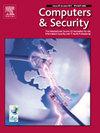A fast modularity hardware Trojan detection technique for large scale gate-level netlists
IF 4.8
2区 计算机科学
Q1 COMPUTER SCIENCE, INFORMATION SYSTEMS
引用次数: 0
Abstract
Hardware Trojans (HTs) are a kind of malicious circuit implanted by adversaries and induce malfunction under rare situations. Attackers may insert HTs into untrusted third-party intellectual properties (3PIPs), thus severely threatening the hardware security of ICs. To overcome this issue, state-of-art HT detection techniques are proposed based on feature extraction of gate-level netlists (GLNs). However, these techniques may take a long time to extract HT signals for large scale GLNs. In this paper, we propose a fast modularity HT detection (FMTD) method for large scale GLNs. The GLN modularity algorithm can divide the whole GLN into several small modules with the boundaries of D flip-flops (DFFs) of each module. By analyzing the transition rate of critical signals, preserving suspicious DFFs, and repairing the ring circuit, we can ensure the integrity of HT circuits during the GLN modularity process. Then, the calculation of the testability of each module is conducted in parallel with our self-designed tool. In the self-designed tool, we repair the ring circuit, calculate the testability values, and calibrate the testability values of module boundary signals. Compared with the EDA tools, our self-designed tool has no upper limit of testability values. Then, the testability values are sent to the unsupervised K-means clustering simultaneously to diagnose the HT signals. Facilitated by the modularity of the GLN, the detection time of 105 order signals sample is reduced by up to 90 % when compared to the traditional COTD method, while our MFTD method shows a similar HT detection performance to that of the traditional COTD method. For all 20 kinds of GLN samples in Trust-hub, our FMTD method can obtain a detection accuracy of 100 %, and signal diagnosis precision of more than 93 % with a diagnosis false positive rate lower than 1 %.
针对大规模门级网表的快速模块化硬件木马检测技术
硬件特洛伊木马(HT)是一种由对手植入的恶意电路,在极少数情况下会引发故障。攻击者可能会在不可信任的第三方知识产权(3PIP)中植入 HT,从而严重威胁集成电路的硬件安全。为解决这一问题,人们提出了基于门级网表(GLN)特征提取的先进 HT 检测技术。然而,这些技术可能需要很长时间才能提取出大规模 GLN 的 HT 信号。本文提出了一种针对大规模 GLN 的快速模块化 HT 检测(FMTD)方法。GLN 模块化算法可以以每个模块的 D 触发器(DFF)为边界,将整个 GLN 分成几个小模块。在 GLN 模块化过程中,通过分析关键信号的转换率、保留可疑的 DFF 和修复环形电路,可以确保 HT 电路的完整性。然后,每个模块的可测试性计算与我们自行设计的工具同步进行。在自行设计的工具中,我们修复环形电路,计算可测试性值,并校准模块边界信号的可测试性值。与 EDA 工具相比,我们的自主设计工具没有可测试性值上限。然后,将可测试性值同时发送给无监督 K-means 聚类,以诊断 HT 信号。在 GLN 模块化的帮助下,与传统的 COTD 方法相比,105 阶信号样本的检测时间最多缩短了 90%,而我们的 MFTD 方法则显示出与传统 COTD 方法相似的 HT 检测性能。对于 Trust-hub 中的全部 20 种 GLN 样本,我们的 FMTD 方法可以获得 100 % 的检测精度,信号诊断精度超过 93 %,诊断误报率低于 1 %。
本文章由计算机程序翻译,如有差异,请以英文原文为准。
求助全文
约1分钟内获得全文
求助全文
来源期刊

Computers & Security
工程技术-计算机:信息系统
CiteScore
12.40
自引率
7.10%
发文量
365
审稿时长
10.7 months
期刊介绍:
Computers & Security is the most respected technical journal in the IT security field. With its high-profile editorial board and informative regular features and columns, the journal is essential reading for IT security professionals around the world.
Computers & Security provides you with a unique blend of leading edge research and sound practical management advice. It is aimed at the professional involved with computer security, audit, control and data integrity in all sectors - industry, commerce and academia. Recognized worldwide as THE primary source of reference for applied research and technical expertise it is your first step to fully secure systems.
 求助内容:
求助内容: 应助结果提醒方式:
应助结果提醒方式:


